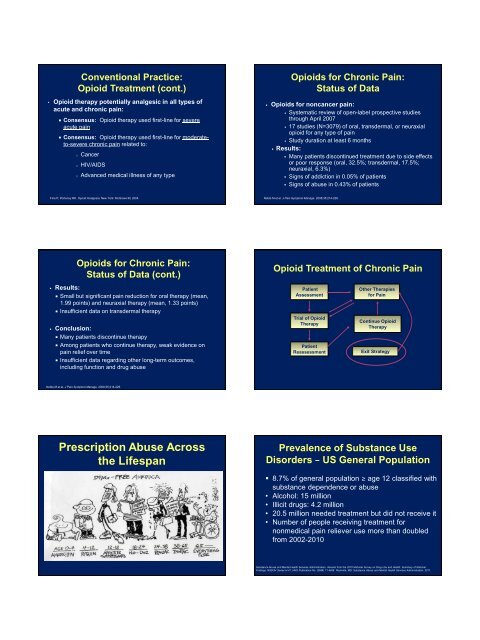Taking Control: Emerging Issues in Pain ... - Pharmacy Times
Taking Control: Emerging Issues in Pain ... - Pharmacy Times
Taking Control: Emerging Issues in Pain ... - Pharmacy Times
Create successful ePaper yourself
Turn your PDF publications into a flip-book with our unique Google optimized e-Paper software.
Conventional Practice:<br />
Opioid Treatment (cont.)<br />
• Opioid therapy potentially analgesic <strong>in</strong> all types of<br />
acute and chronic pa<strong>in</strong>:<br />
• Consensus: Opioid therapy used first-l<strong>in</strong>e for severe<br />
acute pa<strong>in</strong><br />
• Consensus: Opioid therapy used first-l<strong>in</strong>e for moderateto-severe<br />
chronic pa<strong>in</strong> related to:<br />
o<br />
o<br />
o<br />
Cancer<br />
HIV/AIDS<br />
Advanced medical illness of any type<br />
Opioids for Chronic Pa<strong>in</strong>:<br />
Status of Data<br />
• Opioids for noncancer pa<strong>in</strong>:<br />
• Systematic review of open-label prospective studies<br />
through April 2007<br />
• 17 studies (N=3079) of oral, transdermal, or neuraxial<br />
opioid for any type of pa<strong>in</strong><br />
• Study duration at least 6 months<br />
• Results:<br />
• Many patients discont<strong>in</strong>ued treatment due to side effects<br />
or poor response (oral, 32.5%; transdermal, 17.5%;<br />
neuraxial, 6.3%)<br />
• Signs of addiction <strong>in</strong> 0.05% of patients<br />
• Signs of abuse <strong>in</strong> 0.43% of patients<br />
F<strong>in</strong>e P, Portenoy RK. Opioid Analgesia. New York: McGraw Hill; 2004.<br />
Noble M et al. J Pa<strong>in</strong> Symptom Manage. 2008;35:214-228 .<br />
• Results:<br />
Opioids for Chronic Pa<strong>in</strong>:<br />
Status of Data (cont.)<br />
• Small but significant pa<strong>in</strong> reduction for oral therapy (mean,<br />
1.99 po<strong>in</strong>ts) and neuraxial therapy (mean, 1.33 po<strong>in</strong>ts)<br />
• Insufficient data on transdermal therapy<br />
• Conclusion:<br />
• Many patients discont<strong>in</strong>ue therapy<br />
• Among patients who cont<strong>in</strong>ue therapy, weak evidence on<br />
pa<strong>in</strong> relief over time<br />
• Insufficient data regard<strong>in</strong>g other long-term outcomes,<br />
<strong>in</strong>clud<strong>in</strong>g function and drug abuse<br />
Opioid Treatment of Chronic Pa<strong>in</strong><br />
Patient<br />
Assessment<br />
Trial of Opioid<br />
Therapy<br />
Patient<br />
Reassessment<br />
Other Therapies<br />
for Pa<strong>in</strong><br />
Cont<strong>in</strong>ue Opioid<br />
Therapy<br />
Exit Strategy<br />
Noble M et al. J Pa<strong>in</strong> Symptom Manage. 2008;35:214-228.<br />
Prescription Abuse Across<br />
the Lifespan<br />
Prevalence of Substance Use<br />
Disorders – US General Population<br />
• 8.7% of general population ≥ age 12 classified with<br />
substance dependence or abuse<br />
• Alcohol: 15 million<br />
• Illicit drugs: 4.2 million<br />
• 20.5 million needed treatment but did not receive it<br />
• Number of people receiv<strong>in</strong>g treatment for<br />
nonmedical pa<strong>in</strong> reliever use more than doubled<br />
from 2002-2010<br />
Substance Abuse and Mental Health Services Adm<strong>in</strong>istration, Results from the 2010 National Survey on Drug Use and Health: Summary of National<br />
F<strong>in</strong>d<strong>in</strong>gs, NSDUH Series H-41, HHS Publication No. (SMA) 11-4658. Rockville, MD: Substance Abuse and Mental Health Services Adm<strong>in</strong>istration; 2011.



